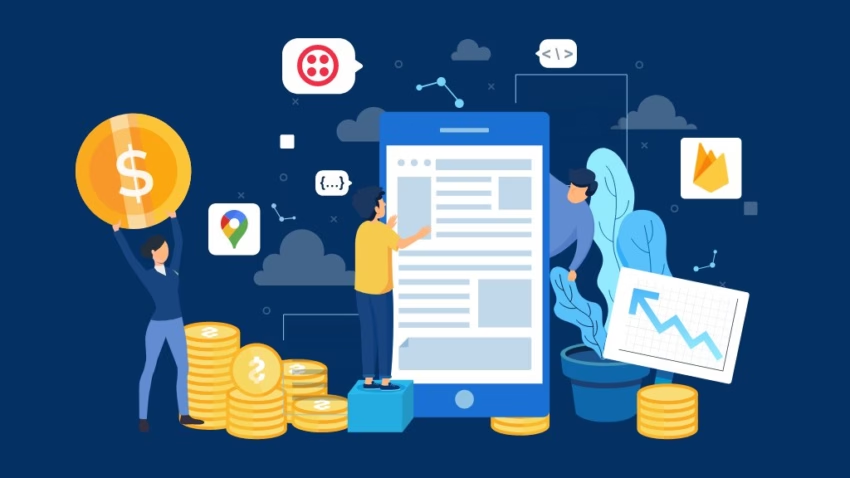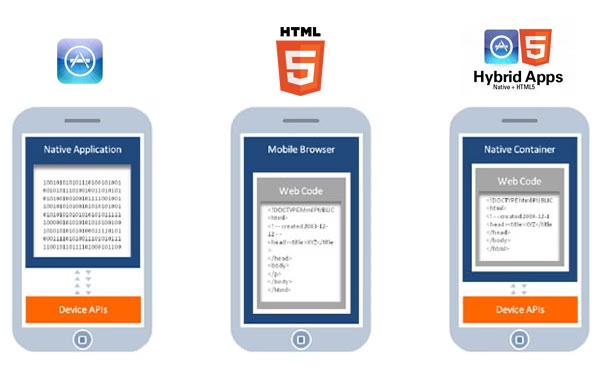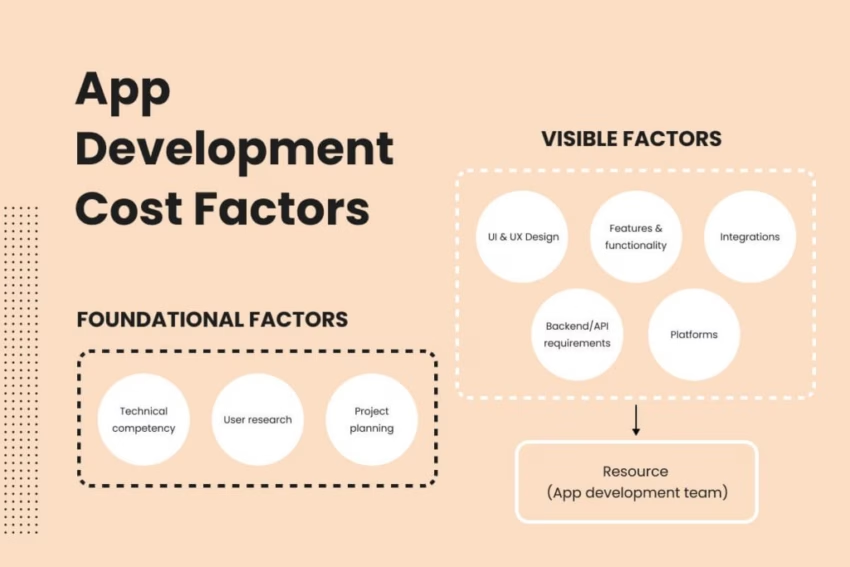- Developers
- Developer Blog
- Mobile App Development
- How to Plan Your Budget for Mobile App Development Project?

profile
Verified Expert
1 year of experience
Alexey Semeney is an entrepreneur, founder, and CEO of DevTeam.Space. He is a product development expert and an occasional writer on different topics related to team management and product development. He is an avid traveler and sports enthusiast.
Wondering how to plan your budget for a mobile app development project?
In this article, we will answer this question by discussing tips on reducing your mobile app development cost and listing 5 cost-saving tips. This article will also answer the most popular questions about mobile app development budget: How to create a budget for app development? What is the average budget for app development? How to estimate app development costs?
Let’s get started!
In this article
- Plan Your App Development Budget
- Best Practices, Trade-Offs, and Decisions to Consider When Deciding Your Budget for App Development Projects
- The Sustainable Way to Reduce the Mobile App Development Cost: Do Things Right the First Time!
- Frequently Asked Questions on a Budget for App Development Project
Plan Your App Development Budget
You must be asking yourself questions like “How much will it cost to build my app?” or “What is the average budget for app development?”. It‘s a pretty significant investment.
Mobile apps are a surefire way to reach your customers because most are already on their phones. According to TechCrunch, consumers spend 85% of their time on a smartphone using mobile apps.
Unfortunately, even mid-size companies struggle to afford the expense of creating their own enterprise app. It’s no secret that mobile application development isn’t cheap — but there are ways to help you cut down on hidden app development costs.
Developing an innovative and feature-rich app requires a deep understanding of notable programming languages, mobile databases, API integrations, cloud infrastructure, app testing, etc.
If you don’t have a professional team with this relevant expertise to take on the task, then submit a request for a complimentary discovery call, and one of our tech account managers who managed similar projects will contact you shortly.
Some of the largest app development companies charge a whopping $500,000 to $1,000,000 to build the app of your dreams. This is great if you’re a large company with millions lying around and want to take a financial risk. Still, for most early-stage businesses, it’s a significant amount requiring fundraising.
Before you outsource your app, there’s something you should know: mobile app development can be really affordable! Don’t let the big guys scare you off. The truth is that most small companies aren’t dropping a million just to make the jump to mobile.
If you’re looking to outsource your app development, the right group of app developers can build your mobile app MVP (minimum viable product) for anywhere from $50,000 to $150,000, depending on product complexity, which is much more obtainable even for early-stage businesses and startups. I’ll show you how to get started with that later.

There are many ways to save money when building a mobile app — and it’s not just down to the specific developers you hire. Here are some tips to help you save big.
Keep It Simple
Mobile app development may seem impossible on a tight budget, but that’s simply not true. It depends on what you ask your developers to make — so it’s important to keep it simple.
Cut costs by doing the following:
- Focus on one or two features that provide the most value to your customers.
- Have a simple, streamlined UI.
You do not need to make the next Facebook. If you try to, your customers probably won’t even care because they already have Facebook. It’s of far greater value to focus on the one specific aspect of your business that customers would want.

Get a complimentary discovery call and a free ballpark estimate for your project
Trusted by 100x of startups and companies like

Think about where mobile is needed — something your customers couldn’t get otherwise. For example, a restaurant doesn’t have to try to be the new Foursquare model and offer in-house deals and mobile ordering but skip out on check-ins and social integration.
In addition, the cleaner and simpler your UI is, the more likely customers will adopt your platform. Users will be turned off by too many features and a cluttered homepage. Adding those things is an unnecessary expense.
Responsive Design is Key
Want your app to run on a ton of devices without having to pay for different designs? Let us introduce you to responsive design — your one-stop shop for a beautiful, budget-saving app.
Normally, if you want a mobile app to run on smartphones, tablets, and laptops, you’d have to create different designs that work for each screen’s size and resolution.
This is the antithesis of cheap mobile app development and will raise your costs through the roof. Instead, a responsive design will give the same look and feel across all screen sizes.
Any good mobile app developer should be able to create a responsive design, but they may try to convince you to have separate designs instead.
Obviously, having different versions of your app that specifically cater to different devices is “better” in a sense, but it’s also unnecessary if you’re looking to cut costs.
A single, responsive design is cheap and effective. Your users won’t know the difference.
Ditch Push Notifications
What if we told you that ditching one feature could save 30% of your budget? Yes, it’s true. The more features an app has, the more expensive it is, but some of these features require ongoing maintenance that jack up the price.
We bring you the seemingly simple idea of Push Notifications (aka, money suck that you should ditch ASAP unless it’s necessary). Here’s why:
- Push Notifications require ongoing maintenance.
- Push Notifications often increase app costs by 20-30%.
- Most users don’t need or want Push Notifications unless it’s integral.
Sometimes, Push Notifications are necessary. If you’re a pharmacy and your mobile app is built around alerting users when their prescriptions are ready, ditching Push Notifications would defeat the purpose of your app.
For every other startup looking to cut costs, ditch it. On-going maintenance and expense are just not worth it.
Cut Down Configurability If Possible
It’s a best practice in app development to include global configurability in elements like text and color. I’d never recommend going without it unless it’s the difference between making an app or scrapping the project.
The truth is that this sucks out a large part of your budget. Making each element configurable takes a lot of work — and work isn‘t free.
Sometimes, it is possible to get around this by ditching configurability in certain elements, though it’s dangerous if you don’t know what you’re doing. Talk to your app developer and come up with a solution together.
Focus on the elements that matter, make those configurable, and leave the rest out.
A Hybrid Mobile App Will Save You Money

Many businesses that develop an app have to create versions for both Android and iOS apps, which means you’re paying for two apps instead of one.
To cut costs down, build a hybrid mobile app. These apps are similar to websites and are developed in HTML, CSS, and JavaScript — a universal language. They’re then wrapped in the required native wrapper — either iOS or Android — which makes them feel like native apps even if they’re not.
There’s another shortcut — you can convert your iOS app to an Android app or the other way around.
Hybrid apps do have some drawbacks. They can be sluggish and difficult to customize. They’re not as cheap as creating a single app for a single operating system, but overall, it cuts 30-40% of your expenses.
Talk to your development team to determine if this is right for you. If your app is simple, the sluggishness may not even matter.
Best Practices, Trade-Offs, and Decisions to Consider When Deciding Your Budget for App Development Projects
We just talked about how you can reduce the cost of app development; however, is it that simple? It might not be.
You must consider several best practices, trade-offs, and decisions in mobile app development. That will ensure that you strike the right balance.
As a project manager undertaking a software development project, consider the following:
1. Would you build a hybrid app as Uber had done?
Uber, the popular ride-hailing service, has a hybrid app. Building a hybrid app is one of the cost-saving tips we discussed above. This does look like a lucrative option when you think of Uber. Is it a good option, though?
You need to consider your business requirements carefully. The first and foremost requirement that Uber fulfills is that it connects users with drivers. By itself, that’s not a complex requirement to fulfill. Modern technologies for geolocation tracking make it pretty easy.
Being a web app, Uber loads fast even if you use a relatively old mobile device. It does meet its primary requirement quickly enough.
Do you have such straightforward overarching requirements? Building a hybrid app can work for you, then.
Hire expert developers for your next project
1,200 top developers
us since 2016
It won’t work if any of the following conditions is true:
- You need to provide the best possible user experience. Therefore, the user interface is of high importance.
- Your proposed app must deliver the best possible performance.
- You need to meet stringent information security requirements.
- Your app provides complex functionalities that use cutting-edge technologies like “Artificial Intelligence” (AI), “Augmented Reality” (AR), etc.
- Your proposed app features make significant use of platform-specific hardware features like Bluetooth, camera, etc.
Build a native Android app and a native iOS app if you need to meet these conditions. Look for developers with native Android development skills, including Java. Find programmers with native iOS development skills like Swift.
2. Smartly managing the mobile backend can provide long-term cost savings
Are you looking to save both development and maintenance costs? Managing the backend effectively while building a mobile application can help.
Building and managing the mobile backend involves the following complexities:
- You need to manage the IT infrastructure.
- Managing databases and storage can take plenty of time.
- You need to manage various API integration requirements.
- You must implement features like push notifications, in-app messaging, user management, and user authentication.
If you lead a startup, you might not have invested in IT infrastructure. You would need to utilize a cloud platform. We recommend you use a “Mobile-Backend-as-a-Service” (MBaaS) platform.
As we have explained in our guide to MBaaS platforms, using an MBaaS delivers the following advantages:
- MBaaS platforms manage cloud infrastructure, servers, persistent storage, etc. This reduces your upfront investment in IT infrastructure.
- Since MBaaS platforms manage the above-mentioned infrastructural aspects, your maintenance efforts are reduced.
- MBaaS platforms make it easier to integrate with various APIs.
- You can easily implement features like push notifications, user management, etc. when using an MBaaS platform.
You can save development and maintenance costs using a reputed MBaaS platform like AWS Amplify or Google Firebase.
3. Rationalize your app features
What do your business stakeholders want? You may have documented their needs. However, how many of them are realistic? Consider this question carefully.
Treat only legitimate and realistic needs as requirements. Engage your business stakeholders in meaningful dialogue and understand their real requirements. Assess the needs for various customization requirements.
Otherwise, you will be left with a very large list of requirements. Many of these requirements might have a limited impact only. Your development cost will go up. However, business users will not see real value.
Use tools like a “Pain and gain map” to understand how each requirement addresses specific pain points of the business users. Utilize modern tools like the “Prioritization matrix” to prioritize requirements.
Read our guide to creating an MVP for more insights.
4. A hybrid web app vs. a near-native app: Rationalize your requirements
We have already discussed the hybrid-vs-native question and would like to expand on it a bit. You now know that a native app is a better bet if you need to use the capabilities offered by an operating system.
What if you decide you don’t need to build a complex app? You might have decided to offer basic features. You would like to provide a high-quality user interface. However, it doesn’t need to match the native experience.
A hybrid app won’t quite do the job for you. This type of basic app will have several gaps when you compare it with a native Android or iPhone app. However, you can undertake a near-native app development process using a framework like React Native.
A React Native app can run on Android and iPhone. It’s a cross-platform app, and you can reuse the code to a large extent. It offers a user experience close enough to native iOS and Android apps; the performance is good.
You don’t need developers with skills in programming languages like Java and Swift since React Native is JavaScript-based. Developers don’t need to use SDKs specific to Android and iOS. You can save on maintenance costs, too. One codebase reduces the maintenance effort requirements.
5. Outsourcing the project to an offshore development team
You can reduce mobile app development costs by outsourcing the project to an offshore development team. You need to contend with trade-offs, though.
The hourly rates will be lower than the rates in matured markets. As a result, the pricing plans charged by an offshore mobile app development company will be cheaper.
However, managing a project involving an offshore app development team can be tricky. Imagine managing developers in Ukraine or elsewhere in Eastern Europe when you are based in the USA! The time-zone differences make real-time collaboration harder.
You will likely spend a higher number of hours on project management. Coordinating tasks like quality assurance can take longer when you work with an offshore app development agency.
We will remind you about another key point, too. Finding a suitable custom software development company offshore can take time. You need to review many companies on sites like Clutch and do quite a bit of homework. Analyze whether the mobile app cost savings are worth the higher app complexity!
6. Should you use a “Low-code” or “No-code” platform to develop a simple e-commerce app?
“Low-code” and “No-code” platforms are gaining popularity. In some cases, using them can save development costs.
A “Low-code” platform provides blocks of codes for standard functionalities, and they provide an intuitive IDE. Developers don’t need to write code for all repetitive and common functionalities.
“Low-code” platforms typically use a prominent cloud computing platform. They also integrate with popular tools like Gmail, Google Drive, Microsoft Teams, etc.
You need a developer if you use a “Low code” platform. However, you don’t need an experienced developer. The developer needs to code only the unique or customized features of the app. This saves development time and cost.
A “No-code” platform offers everything that a “Low-code” platform provides. Additionally, it allows even people without any programming skills to create apps. Business users can choose templates, layouts, and integrations to create an app without coding.
Should you use these platforms? You can only use them if you are developing a simple app like e-commerce. Consider a “Low-code” platform if you don’t have experienced developers. Explore a “No-code” platform if you don’t have an in-house development team, e.g., all developers are busy with other projects.
Hire expert developers for your next project
These platforms aren’t suitable for complex apps. You can’t customize your app if you use these platforms. Furthermore, you will be “locked in” with a particular cloud provider. These platforms have other limitations too, e.g., you can only create hybrid mobile apps using them.
7. Can you reduce app maintenance costs?
We are mainly talking about app development costs. However, app maintenance costs have an impact on the lifecycle costs, too. The good news is that you have several ways to reduce maintenance costs.
You can bake in a few best practices in the development process for that. E.g.:
- Keep maintainability in mind during the app design phase.
- Choose a software app architecture pattern that makes maintenance easier.
- Keep simplicity in mind when coding.
- Follow software development best practices and provide enough comments in your code.
You can also find a cheaper service provider for app maintenance services. After all, the maintenance of a mobile app isn’t the same as development. You would take care of most bugs during the post-deployment or warranty phase.
An offshore maintenance team with low hourly rates should be all right. Remember to implement adequate governance and communication processes and ensure the service provider invests in project management.
8. Should you use freelancers to reduce the average app development cost estimate?
We recommend reviewing your mobile app development project requirements sufficiently before hiring freelancers. You might be able to bargain for a low hourly rate. However, this option has its risks.
Are you building simple consumer apps like WhatsApp or an e-commerce app? You will have limited development effort. Your work will mainly consist of the following:
- Code the key functionalities;
- Design the user interface;
- Provide integrations with popular tools;
- Provide social media integration;
- Test the app;
- Publish the app to app stores like Google Play and/or the Apple App Store.
The limited scope of such apps makes it easier to add new features, too. You might succeed with freelancers in such projects.
However, you should avoid freelancers if you have a more complex project. Managing the work of part-time freelancers can be challenging, and time-zone differences make it more challenging. Freelancers might leave your project mid-way. You must find a replacement developer, which will delay your project.

The Sustainable Way to Reduce the Mobile App Development Cost: Do Things Right the First Time!
Now that we have talked about various tips, trade-offs, and considerations concerning keeping the development costs down for your budget for app development, let’s talk about the most sustainable way. It’s simple: “Get things right the first time”!
You do this in the following ways:
1. Manage requirements smartly when outlining the budget for app development
Analyze the target audience of your proposed app. Work closely with the business stakeholders to get the requirements right. Onboard a competent architect to get the non-functional requirements (NFRs) right and manage the requirements effectively.
2. Formulate an effective software development approach
Work with the project manager and architect to formulate an effective development approach. This involves the following:
- Choose the right software development lifecycle
- Determine whether to develop native apps or a near-native/hybrid app.
- Choose the right architectural pattern.
- Select the right cloud computing platform.
- Choose an appropriate technology stack.
- Identify external APIs/SDKs if applicable. Plan to develop your APIs.
- Identify the testing frameworks and tools.
- Earmark the right DevOps methods, processes, and tools for your project.
- Estimate the project using our estimation guide.
- Plan the project effectively using our guide.
3. Focus on application security while planning the budget for your app development project
The best mobile app you build will be ineffective if you don’t pay attention to application security. Any data breach will impact your reputation adversely, and you might face regulatory challenges in heavily regulated industries.
Save costs over the long term by securing your app. Do the following:
- Use modern tools and techniques like multi-factor authentication (MFA), antivirus, firewall, encryption, digital signature, etc.
- Mitigate application security risks proactively.
- Pay sufficient attention to security and compliance testing.
- Secure your APIs effectively.
4. Get the right development team
Hire competent developers. An effective development team can make your software development journey a smooth one. Such a team takes ownership of the project objectives and organizes itself well.
Competent and high-performing software development teams foster collaboration. This teamwork keeps your project within the schedule, which prevents cost overruns.
5. Catch defects early to ensure an effective budget for your app development process
You will surely test your app, and that goes without saying! However, you can find defects earlier. Successful software development teams institute thorough reviews. These include requirements review, specifications review, code review, and test plan review.
Find experienced reviewers. Unearthing defects early in the lifecycle prevents cost overruns.
Planning Your Budget for App Development Projects?
Low-cost mobile app development is possible with the right team and the right app idea. App development cost breakdown is always a balance of customization and app functionality, but saving in the right ways can greatly increase your ROI.
We hope that we managed to give you some ideas on how to save money when building a mobile app. If you need help finding the right team with exceptional mobile app development services to make your money-saving app, DevTeam.Space can help you.
Post a request explaining your project, and they’ll put you in touch with the talent you need to build the app of your dreams.
DevTeam.Space is an innovative American software development company with over 99% project success rate. DevTeam.Space builds reliable and scalable custom software applications, mobile apps, websites, live-streaming software applications, speech recognition systems, ChatGPT and AI-powered solutions, and IoT solutions and conducts complex software integrations for various industries, including finance, hospitality, healthcare, music, entertainment, gaming, e-commerce, banking, construction, and education software solutions on time and budget.
DevTeam.Space supports its clients with business analysts and dedicated tech account managers who monitor tech innovations and new developments and help our clients design, architect, and develop applications that will be relevant and easily upgradeable in the years to come.
Frequently Asked Questions on a Budget for App Development Project
Devise your budget for app development projects by considering the following:
• Detail specs and features of the app;
• Work out hours required to build an app;
• Establish infrastructure budget;
• Work out a marketing budget;
• Dev hours x developer cost per hour + infrastructure and marketing costs = budget.
Never try to save money by hiring cheap developers. This is a huge no-no and will cost you far more in the long run. Always hire top developers to ensure your project is built on time and on budget.
You can find great programmers at DevTeam.Space. It is a community of field-expert developers with expertise in all the latest tech stacks.

Alexey Semeney
Founder of DevTeam.Space
Hire Alexey and His Team To Build a Great Product
Alexey is the founder of DevTeam.Space. He is award nominee among TOP 26 mentors of FI's 'Global Startup Mentor Awards'.
Alexey is Expert Startup Review Panel member and advices the oldest angel investment group in Silicon Valley on products investment deals.


